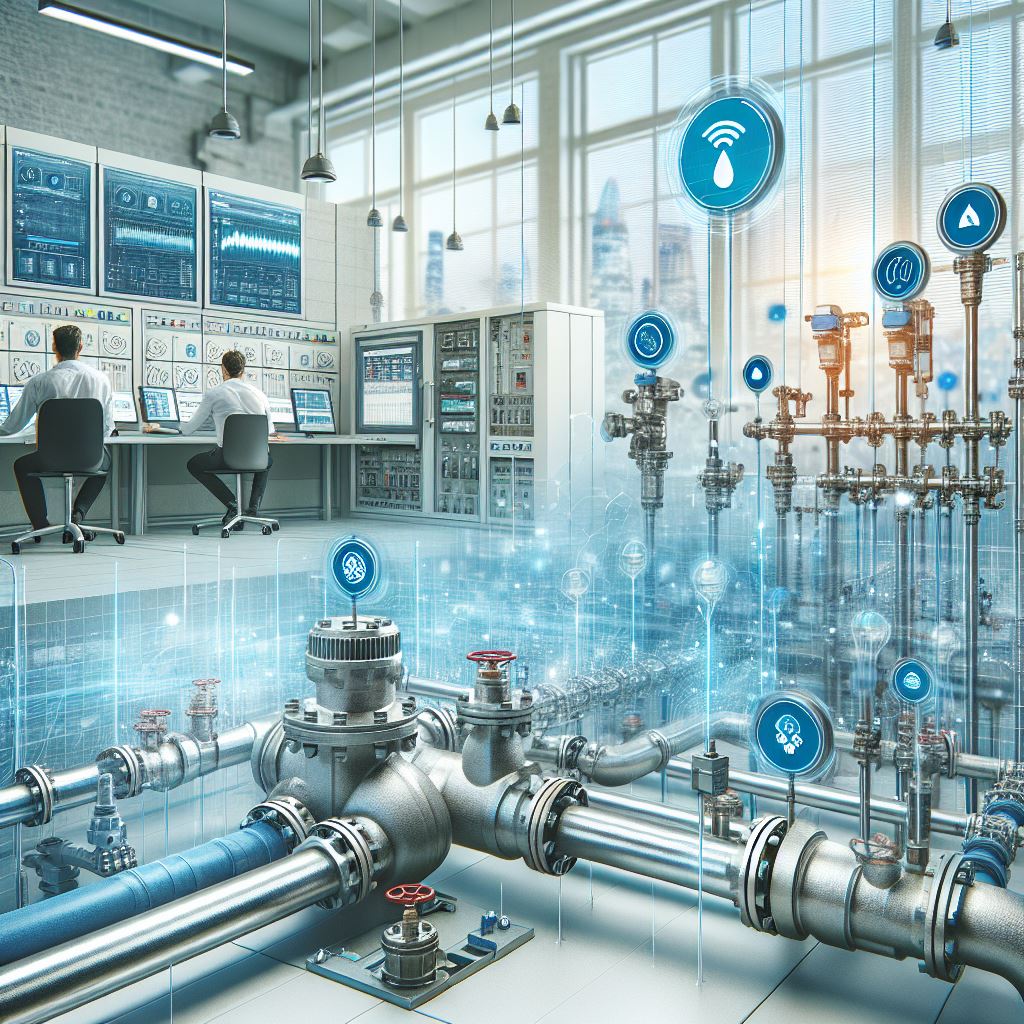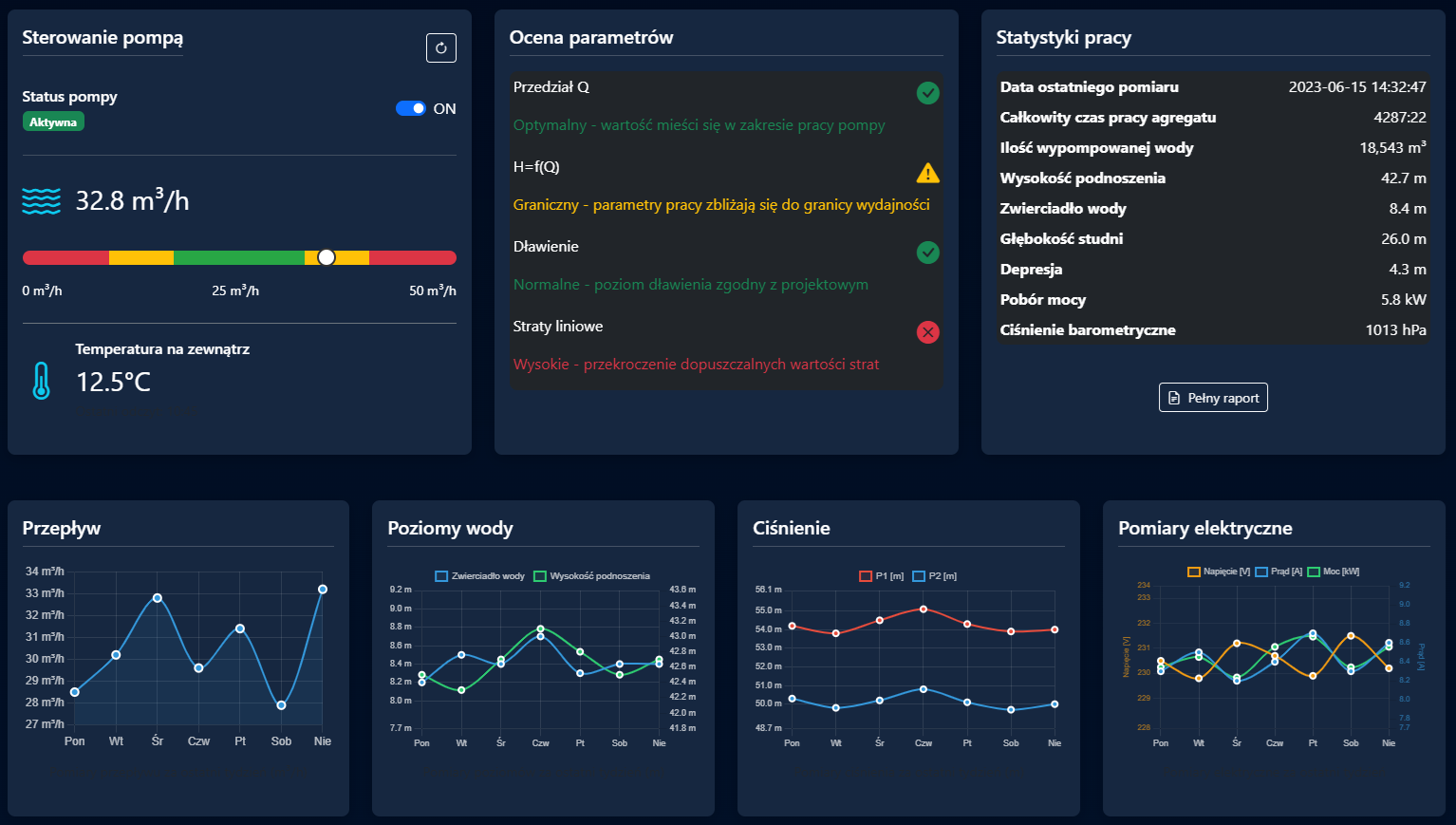IoT Revolution in Water Infrastructure Management
The Internet of Things (IoT) is revolutionizing how water utilities monitor, manage, and optimize their water distribution systems. This technology enables the integration of physical devices with digital networks, allowing the collection and analysis of vast amounts of real-time data, which translates into significant improvements in operational efficiency, resource conservation, and enhanced service quality for consumers.
In this article, we discuss how the Internet of Things is transforming the water sector, present key technologies, and analyze the benefits and challenges associated with their implementation. Special attention is given to practical aspects of IoT application in monitoring and controlling deep well pumps and their integration with modern SCADA systems.
According to Global Water Intelligence report, the global market for IoT technologies in the water sector will reach $25 billion by 2026, growing at a rate of over 18% annually. IoT implementations in water infrastructure can reduce water losses by up to 30% and lower energy costs by 20-25%.
Key Components of IoT in Water Supply Systems
1. Smart Sensors and Measuring Devices
The fundamental elements of the IoT ecosystem in the water sector are advanced sensors and measuring devices that monitor various parameters, such as:
- Water flow at different network points
- Pressure in pipelines and pump stations
- Water quality parameters (pH, turbidity, chlorine content, etc.)
- Water levels in tanks and deep wells
- Energy consumption by pumps and other equipment
- Equipment operational parameters (temperature, vibration, noise)
Modern IoT sensors are energy-efficient, often powered by batteries or renewable energy sources, enabling installation even in remote and hard-to-reach locations. Many utilize wireless communication (LoRaWAN, NB-IoT, Sigfox), eliminating the need for costly cable infrastructure.

Set of smart IoT sensors used in modern water supply systems
2. Communication Networks and Data Transmission Protocols
A key element of IoT technology is communication networks that enable data transmission from sensors to central systems. Various communication technologies are used in water infrastructure, depending on specific requirements:
- LoRaWAN - low power, long-range technology, ideal for distributed sensor networks
- NB-IoT (Narrowband IoT) - utilizes existing cellular network infrastructure, providing good coverage even in hard-to-reach locations
- Sigfox - low-energy technology dedicated to devices transmitting small data packets
- Wi-Fi and Ethernet - used mainly in central locations where fixed infrastructure is available
- Bluetooth and Mesh - used in local sensor clusters
Communication protocols such as MQTT, CoAP, or HTTP REST ensure standardization of data transmission and facilitate the integration of various devices into a unified ecosystem.
3. Data Management Platforms and Analytics
Data collected by IoT sensors must be gathered, processed, and analyzed to provide valuable information. Modern IoT platforms for the water sector offer the following functions:
- Collection and storage of vast amounts of data (Big Data)
- Real-time data processing
- Advanced analytics and machine learning for pattern and anomaly detection
- Data visualization through intuitive dashboards
- Generation of alerts and notifications
- Integration with SCADA and ERP systems of the enterprise
Cloud solutions are becoming increasingly popular as they offer scalability, flexibility, and data accessibility from any location, which is particularly important for distributed water supply systems.

Example of an IoT analytical dashboard for monitoring water network parameters
Key Applications of IoT in Water Supply Systems
1. Distribution Network Monitoring and Management
IoT has revolutionized the way water distribution networks are monitored and managed, particularly in terms of:
- Leak detection - pressure and flow sensors combined with advanced algorithms enable early detection and localization of leaks, reducing water losses
- Water quality monitoring - continuous measurement of quality parameters at various network points helps quickly identify problems and ensure compliance with standards
- Pressure optimization - dynamic pressure management in the network based on sensor data reduces the risk of failures and saves energy
- Network sectorization - division of the network into monitored District Metered Areas (DMAs) facilitates management and problem localization
2. Pump and Equipment Optimization
Pumping systems are among the largest energy consumers in water utilities. IoT enables significant optimization of their operation through:
- Continuous monitoring of operational parameters (flow, pressure, power consumption, temperature)
- Adaptive control based on demand and operating conditions
- Scheduling operation during lower energy tariff periods
- Detection of anomalies indicating potential problems (vibrations, overheating)
- Predictive maintenance based on the actual condition of equipment
The HydroNexis system integrates with IoT sensors to provide comprehensive management of deep well pumps, optimizing their operation and extending their lifespan.
3. Smart Metering and Demand Management
Smart water meters are one of the most widespread IoT applications in the water sector. They offer the following benefits:
- Remote real-time readings
- Detection of abnormalities and potential leaks at customer sites
- Detailed analysis of consumption patterns
- Dynamic management of tariffs and incentives for customers
- Better demand forecasting
Data from smart meters, combined with information from the distribution system, allows for precise flow balancing and identification of water loss areas.
Case Study: United Kingdom - Yorkshire Water
Yorkshire Water, one of the largest water utilities in the UK serving over 5 million customers, implemented a comprehensive IoT system to monitor its infrastructure. The project included:
- Installation of over 40,000 smart sensors throughout the network
- Utilization of LoRaWAN technology for communication
- Advanced analytics for leak detection and anomalies
- Integration with the existing SCADA system
After 18 months of implementation, Yorkshire Water reported:
- 22% reduction in leaks
- 33% decrease in water supply interruptions
- 60% shorter response time to failures
- 15% energy savings
- Return on investment achieved after 2 years
Challenges and Solutions in IoT Implementation
1. Data Security and Cybersecurity
The integration of IoT devices with critical infrastructure, such as water systems, creates serious security challenges. Key protective measures include:
- Encryption of data transmitted between devices and analytical platforms
- Two-factor authentication and device identity management
- Network segmentation and firewalls
- Regular software updates and security patch management
- Network activity monitoring to detect suspicious activities
- Regular security audits and penetration testing
The "security by design" approach should be a fundamental principle when designing IoT systems for water infrastructure.
2. Integration with Existing Systems
Most water utilities already have various IT and OT (operational technology) systems. Integrating new IoT solutions with existing infrastructure presents a significant challenge. Key aspects include:
- Use of standard communication protocols (OPC UA, MQTT, REST API)
- Implementation of middleware for translation between different systems
- Design of architectures based on microservices and APIs
- Use of ESB (Enterprise Service Bus) or iPaaS (Integration Platform as a Service) technologies
The HydroNexis system has been designed for easy integration with IoT devices and existing systems, using open standards and modular architecture.
3. Scalability and Reliability
Water infrastructure is a critical system that must operate reliably 24 hours a day, 365 days a year. IoT solutions must meet high requirements regarding:
- Resistance to harsh environmental conditions (moisture, temperature, corrosion)
- Long battery life or alternative power supply
- Redundancy of key components
- Capability to operate offline in case of connectivity loss
- Scalability to handle growing numbers of devices and data volume
Cloud-based architectures with local edge computing offer the best combination of scalability and reliability.
The Future of IoT in Water Supply Systems
IoT technologies in the water sector will evolve towards even greater autonomy, intelligence, and integration. Upcoming trends include:
- Digital Twins - digital replicas of entire water systems, enabling advanced simulations and optimizations
- Advanced Analytics and AI - use of artificial intelligence for autonomous decision-making and problem prediction
- Augmented Reality (AR) - supporting field and service work by overlaying IoT sensor data on the real image of infrastructure
- Drones and Robots - autonomous devices for inspection and monitoring of hard-to-reach infrastructure elements
- Blockchain - ensuring non-repudiation and reliability of data collected by IoT sensors
Water utilities that are already investing in IoT technologies are building foundations for future, fully digital water infrastructure management.
Summary
The Internet of Things is fundamentally changing how water utilities manage their infrastructure. IoT technologies enable precise monitoring, proactive maintenance, and operational optimization, which translates into tangible economic, environmental, and social benefits.
Implementing IoT is not a simple task, however - it requires a thoughtful approach considering security issues, integration with existing systems, and a long-term data management strategy. The HydroNexis system, with its open architecture and advanced analytical functions, is an ideal complement to the IoT ecosystem in water infrastructure.
The future belongs to intelligent, integrated, and autonomous water systems, and IoT technologies are the key to this transformation.


Comments (9)
Robert Lewis
August 20, 2023, 18:32
Very well-described topic! I work in a medium-sized water utility, and we're currently considering implementing IoT sensors to monitor our network. We're particularly interested in solutions for early leak detection. What specific pressure sensors would the author recommend for a network primarily built with PE pipes of 110-250 mm diameter?
Alice Cooper
August 19, 2023, 14:45
I missed information about the maintenance costs of IoT infrastructure in the article. Sensors are one thing, but then there are data transmission costs, cloud maintenance, analytics. How are these costs distributed over time, and is the return on investment after 2 years still realistic for smaller utilities?
Thomas Walker Author
August 19, 2023, 16:20
Thank you for the valuable question! Indeed, TCO (Total Cost of Ownership) is a key aspect. For smaller utilities, I recommend hybrid solutions - some analytics locally, with only the most important data sent to the cloud. Transmission costs can be optimized by choosing technologies like LoRa or Sigfox, where fees are low. For utilities serving 20-50 thousand residents, a realistic ROI is 2.5-3 years, but this can be accelerated through digital transformation grant programs.
Michael Adams
August 19, 2023, 11:05
What about standardization in the area of IoT for water utilities? Are there any recognized norms or industry standards? I'm concerned about vendor lock-in situations where we would be dependent on a single technology provider.
Caroline Miller
August 18, 2023, 21:35
Great article! We implemented a similar IoT system in our water utility a year ago, and the results are truly impressive. The biggest benefit for us was the drastic reduction in time needed to detect and locate leaks. Previously, this could take days; now we often identify the problem within an hour. If anyone is planning a similar investment, I recommend paying particular attention to sensor quality - not all perform equally well in difficult conditions.
John Newman
August 18, 2023, 16:18
Regarding cybersecurity - are there any specific regulatory guidelines for securing IoT systems in critical infrastructure? I work for a company that conducts security audits, and we see that this area is often insufficiently regulated.
Add a Comment